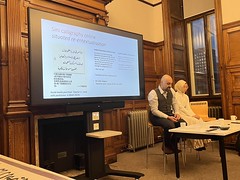Plato in his Phaedrus talks about the ‘fysikEs arthrOsis’ or ‘natural joints’ of entities and phenomena. He suggests that thinking about phenomena is like slaughtering an animal: that judicious knowledge of ‘joints’ and connections is imperative, and taken-for-granted, arbitrary, and organisational notions of connections are a distraction. If you want to understand any entity (whole), therefore, you need to explore its relations with other entities (parts). This can be with humans and non-humans, and you have to know where to cut, you need to explore the joints and connections. The ‘whole’, therefore, can be said to be smaller than the sum of its constituent parts in a sociomaterial assemblage. This thought is part inspired by a video I was watching last night here:
As entities in the social world, you could say we are made up of many relations like we are puppets held up by strings. Every string is an affiliation, connection, relation, etc to another entitiy (human and non-). The study of an entity (whole) entails an exploration of those ‘strings’ (parts). They are the interesting part. Online profiles/CVs (resumes) are a blatant realisation of this, as we all leave digital traces.
The whole, therefore, can be said to be smaller than its parts – if we adopt the topology that what is ‘next to’, ‘above’, or ‘between’ social actors is not defined or accounted for by metric distance or Euclidean three-dimensionality, but seen in terms of entities’ fluid patterns of relations which are not bound by our simple notion of space-time. For example, through the various activities carried out through it, a computer in a classroom can: facilitate writing activities, be a community builder, maintain friendships, be a symbol of a school’s prestige and investment in technology and is photographed in glossy marketing material, a presence to satisfy quality assurance that ‘e-learning’ is taking place, etc, etc. Latour’s words come to mind here:
“The smallest aids virus takes you from sex to the unconscious, then to Africa, tissue cultures, DNA and San Francisco, but the analysts, thinkers, journalists and decision-makers will slice the delicate network traced by the virus for you into tidy compartments where you will find only science, only economy, only social phenomena, only sentiment, only sex”.
(Bruno Latour, ‘We have Never Been Modern’: pp.2-3)
In this respect, the parts that make wholes are amazingly complex, fluid, and interesting. They are hugely bigger than the whole, imho. Just a thought.
Digital environments throw up space-time reconfigurations; they result in a remediation and rematerialisation, and we would do well by exploring these as part of technology-related research.
Categories: PhD Reflections, Technologies, Uncategorized












Very interesting. While theoretically it is true to maintain that digital spaces reconfigure time-space dimensions, I am not sure about the access to truly empowering digitial resources and the symbolic access. I guess it is important to see the social implications beyond the purported claims of digital revolution. Thanks for sharing. Khan
Hi, Khan
Seeing beyond the purported claims of the digital revolution, and “cybernetic totalists” (cf Jaron Lanier) is vital.
When it comes to the sociomaterial assemblage, i.e. how the ‘social’ and ‘material’ are knit together in a mutually constitutive way, then my thoughts in this post are about how to ‘cut off’ where we observe actors’ activities. Now modernism sought to give us plenty of pigeon holes: who is black, white, what is a ‘context’, etc. But I think things are far more complex than that, particularly in digital environments.
Thanks for the comment 🙂